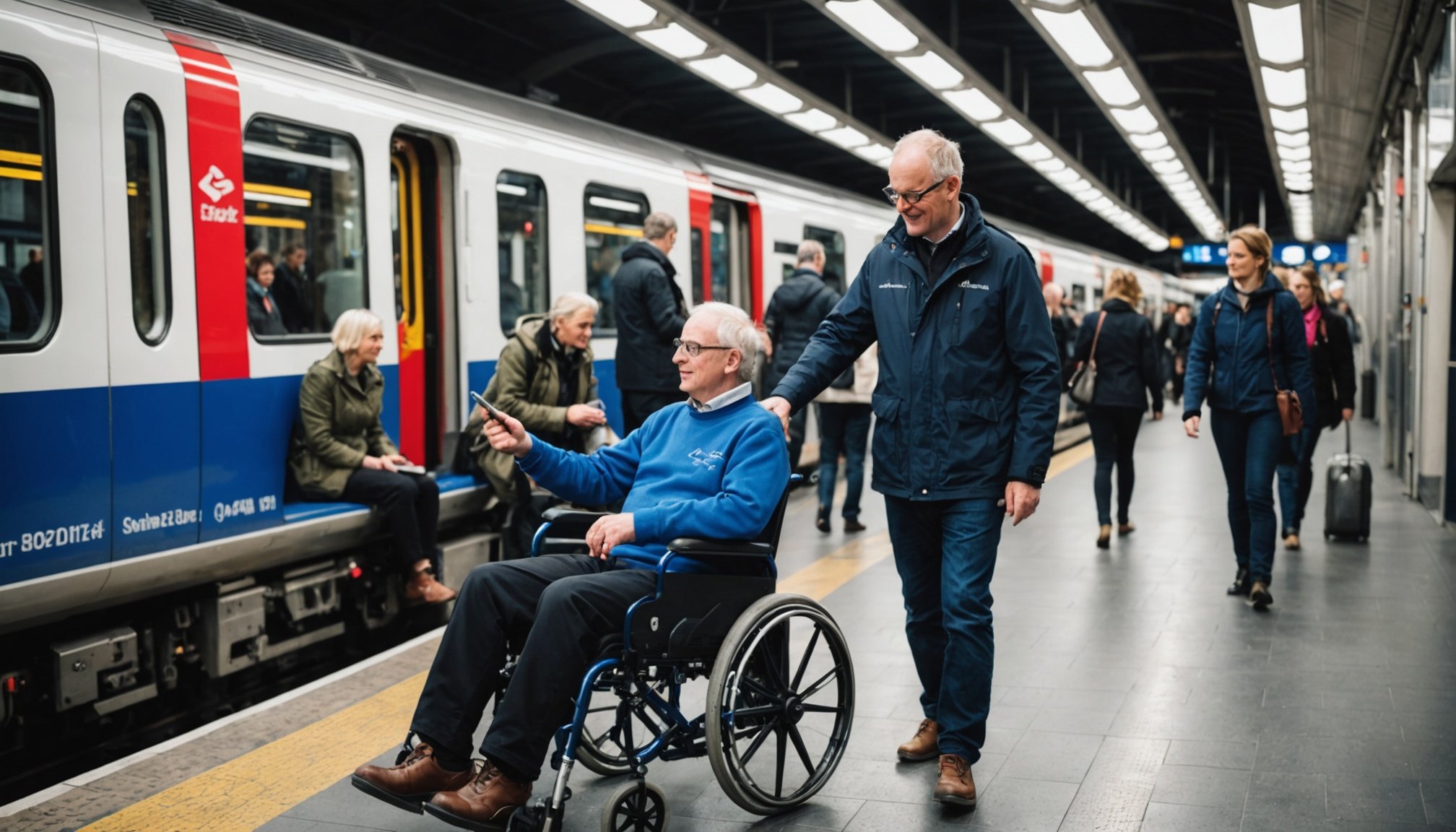Overview of Current Accessibility Measures in UK Train Services
Navigating UK train services can be challenging without the right accessibility measures. Many initiatives have been made to ease travel for passengers with disabilities. At train stations, tactile paving, ramps, and elevators facilitate access for those with mobility issues. Additionally, visual and auditory information systems cater to passengers who are blind or deaf, ensuring they get the necessary travel details clearly and efficiently.
Recent upgrades have focused on enhancing both stations and trains, with newer carriages featuring wide aisles and dedicated spaces for wheelchairs. These efforts signify a positive shift towards more inclusive travel. Passengers with disabilities now encounter fewer obstacles thanks to lowered ticket counters and improved boarding processes, including boarding ramps and assistance staff at major stations.
Have you seen this : Unravel new treasures with your daily mystery box
The commitment to inclusivity also extends to compliance with legal standards. UK train operators must adhere to regulations like the Rail Vehicle Accessibility (Non-Interoperable Rail System) Regulations 2010. Such compliance ensures that the needs of all passengers are considered and acted upon.
Despite significant progress, ongoing reviews and updates are necessary to keep accessibility measures aligned with evolving needs. In striving to create a seamless travel experience, UK train operators remain devoted to making train travel welcoming for everyone.
Also read : Upgrade your wandsworth property through skilled loft conversions
Government Initiatives and Policies
Exploring the intersection of government policies, transport accessibility, and disability rights unveils a landscape of legislative frameworks designed to ensure equitable transit solutions. Central to this is a robust series of laws enhancing mobility for individuals with disabilities.
Overview of Major Legislation
At the heart of transformative changes in transport accessibility are key pieces of legislation. The Equality Act mandates non-discriminatory practices, providing a legal backbone supporting fair access. Moreover, the ADA (Americans with Disabilities Act) is pivotal in imposing explicit requirements on public transport systems to accommodate all users effectively.
Funding Allocations for Accessibility Projects
Financial backing is crucial for the successful implementation of transport accessibility initiatives. Government policies dedicate funds specifically aiming to enhance the travel experience for those with disabilities. These allocations involve billions in annual investments, earmarked for station modifications, platform adjustments, and advanced transit technologies.
Role of Transport Authorities
Transport authorities play an instrumental role in enforcing accessibility standards derived from government policies. Their responsibilities include conducting audits to ensure compliance, providing guidance for improvement projects, and fostering an environment where disability rights are prioritized. Effective collaboration between these entities and governmental bodies ensures that transport systems evolve to be inclusively accessible, aligning with legislative expectations.
Passenger Experiences and Testimonials
Passenger feedback plays a crucial role in shaping accessible train travel. Many notable personal stories have highlighted both triumphs and challenges of the travel experience. Disabled passengers often recount their journeys, sharing insights that can be instrumental for future improvements.
One common theme in these testimonials is the lack of proper facilities for the disabled. From difficult boarding processes to inadequate seating arrangements, the accessibility experience can be daunting. However, passengers have also praised the efforts of staff members, who often go above and beyond to assist with special needs.
Reflecting on these experiences, passengers have suggested several enhancements. First, there is a call for more visible and clear signage to guide the physically challenged. Additionally, personal stories frequently cite the need for more space for wheelchairs, accessible toilets, and support services. Moreover, training staff to better understand the implications of disability can make a world of difference in ensuring a seamless travel experience.
In conclusion, by embracing this valuable passenger feedback, train operators can address common barriers. With the right changes, the landscape of train travel can become more inclusive and welcoming, aligning services with the needs of all travelers.
Statistical Insights on Disability and Transport
In recent years, there has been a growing interest in understanding the statistics on disability and the challenges faced by individuals in accessing transport. To address these concerns, detailed data analysis has been conducted to provide insights into the current situation.
Overview of Disability Demographics in the UK
The UK is home to a significant number of individuals with disabilities, a vital demographic to consider for enhancing transport accessibility. Recent studies indicate that approximately 22% of the population is affected by a disability, which underscores the need for inclusive transport solutions. This demographic includes a wide range of conditions, from mobility impairments to sensory disabilities, all of which require adaptive options for commuting.
Impact of Accessibility on Travel Behavior
Transport accessibility significantly affects the travel behaviour of disabled individuals. When accessibility measures are inadequate, it results in reduced usage of public transport. For instance, inaccessible stations and vehicles can deter travel, impacting daily activities and overall quality of life. Improving these facets is crucial for empowering disabled passengers to travel independently.
Analysis of Survey Results
Surveys conducted reveal crucial insights into the perceived levels of accessibility by disabled individuals. Respondents frequently note challenges such as the lack of step-free access and inadequate assistance services. Analysing these results helps highlight areas in need of improvement, guiding efforts towards more accessible transit systems that cater to everyone’s needs.
Expert Opinions and Case Studies
Understanding the transformative potential of inclusive transport systems is crucial. In recent years, contributions from accessibility experts and advocates have brought light to innovative methods that can enhance public transport services. Experts emphasise the need to prioritise accessibility in train services, making them more presentable to a broader audience. These professionals suggest integrating universal design principles, which benefit everyone, including individuals with disabilities.
Case studies reveal multiple instances where train service transformations have set a precedent for inclusivity. For example, some regions have successfully reduced travel barriers by implementing step-free access and audible announcements. These transformations have not only enhanced the commuter experience but also increased service usage, showcasing the positive impact of thoughtful design.
Looking ahead, recommendations from experts focus on continual evaluation and adaptation. They urge transport authorities to employ comprehensive audits and adopt a feedback-driven approach to maintain an inclusive environment. By offering training for staff on accessibility needs and encouraging collaboration with advocates, future improvements can be both sustainable and effective.
Undoubtedly, the pioneering efforts in accessible transport highlight the power of inclusive design. These advancements remind us of the benefits that can be achieved through expert insights, thoughtful planning, and dedicated implementation.
Recommendations for Further Enhancements
Exploring avenues for future accessibility improvements is crucial to cultivating inclusive environments. Let’s dive into several technological and community-driven strategies that exhibit promise.
Technology Integration for Accessibility
Recent advancements have introduced innovative technologies that can significantly enhance accessibility. Smart devices with voice-activated capabilities, such as voice assistants, offer effortless interaction for individuals with disabilities. These innovations are making strides in simplifying daily tasks, from controlling home appliances to accessing information online. Furthermore, adaptive interfaces that adjust according to specific user needs present promising solutions. Technologies like eye-tracking for computer navigation ensure smoother digital experiences and promote independence.
Community Engagement in Accessibility Planning
The inclusion of disabled communities in planning processes is a decisive factor in making spaces truly accessible. Engaging with these communities offers invaluable insights into real-world challenges and preferences, enabling tailored solutions that meet genuine needs. Advocacy groups play a pivotal role, providing a platform for direct feedback and ensuring their voices are heard and respected in decision-making.
Enhancing Staff Training and Awareness
Staff training is essential for fostering an environment that prioritises accessibility. By training personnel on best practices and equipping them with knowledge about disability etiquette, organisations can substantially improve the user experience. Regular workshops and awareness programmes ensure that staff members remain updated on advancements in accessibility, leading to a more inclusive atmosphere.











